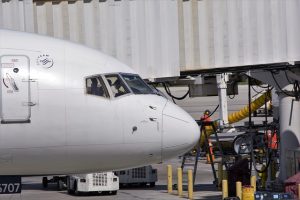
Cockpits don’t feature the same type of windshields as passenger windows. They are typically thicker and stronger. Cockpit windshields are a critical component of an airplane’s cockpit. They serve several important functions while promoting safety in the process. Here are some interesting facts about cockpit windshields:
#1) Designed to Withstand Bird Strikes
Because they are located at the front of the airplane, cockpit windshields are designed to withstand bird strikes. According to the U.S. Fish and Wildlife Service (FWS), bird strikes — along with other animal strikes — cause over $900 million in aircraft damage per year. With their reinforced construction, though, cockpit windshields can withstand many instances of bird strikes.
#2) Made of Glass or Plastic
Most airplanes feature glass or plastic cockpit windshields. They aren’t made of traditional glass or plastic. Rather, the glass or plastic is initially strengthened with chemicals. Once strengthened, it’s used to create the cockpit windshields. These chemically strengthened glass and plastic windshields are significantly stronger than their plain glass and plastic counterparts.
#3) Features Multiple Layers
Cockpit windshields consist of multiple layers. Whether made of glass, plastic or both of these materials, they typically feature multiple layers of their respective material. The Airbus A320, for instance, features three layers. The outermost layer is just 3 millimeters thick, whereas the inner two layers are 9 millimeters thick. The outermost layer of the A320’s cockpit windshield serves as a protective barrier.
#4) Leverages a Coating
Some cockpit windshields may have a special coating applied to the outermost layer to help reduce sun glare and increase visibility. This coating may also have anti-icing properties to prevent ice buildup on the windshield during cold weather operations. Airplanes are exposed to subfreezing temperatures during high-altitude flights, so many of them require the use of an anti-icing coating.
#5) Undergo Impact Testing
Cockpit windshields must undergo impact testing during their design. Impact testing can be performed using a variety of methods, such as bird strike simulations, impact tests with different objects and tests to simulate extreme flight conditions like rapid decompression.
#6) Requires Maintenance
There are different types of cockpit windshields, but they all require some form of maintenance. Maintenance is necessary to ensure their continued effectiveness and safety. Cockpit windshields need to be regularly cleaned and polished to remove dirt, debris and any potential contaminants that could affect visibility or jeopardize their structural integrity.



